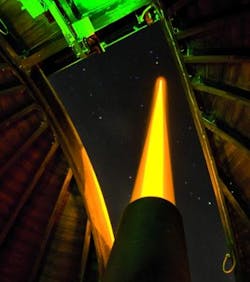Delivery of first Toptica sodium-guide-star laser accepted by European Southern Observatory, four more coming right up
Toptica (Munich, Germany) has been creating a new generation of sodium-guide-star lasers intended for use with the adaptive optical (AO) systems integrated into future ground-based extremely large telescopes (ELTs). The development is now done, and the delivery of the first Toptica guide-star laser has been accepted by the European Southern Observatory (ESO); this laser will be sent to ESO’s Adaptive Optics Facility at the Very Large Telescope (VLT) in 4200-meter-high Paranal, Chile.
Between now and August 2014, Toptica will complete the delivery of four of these lasers plus one spare unit to the ESO, which is hoping to achieve "first light" with the guide-star system at the VLT in Paranal in early 2015. Four of these yellow-emitting (589 nm) lasers will excite natural sodium atoms in the Earth’s mesosphere at an altitude of 90 km, creating “artificial stars” for the telescope's AO system.
The laser systems each consist of a narrowband and tunable diode laser with 30 mW output power at 1178 nm, a Raman-shifted fiber-amplifier stage developed by MPB Communications (Pointe-Claire, QC, Canada), and a subsequent resonant-frequency doubling stage. The output frequency is actively locked to a high-resolution precision wavelength meter made by HighFinesse GmbH (Tübingen, Germany). The work was performed under a multiyear ESO development contract, using the ESO fiber Raman amplifier (EFRA) license for the amplifier potion.
Repumping increases brightness by 2.5X
The laser head that will be directly installed onto the guide star launch telescope can be spatially separated by up to 27 m from the bulky and high-energy consumption part of the laser system. It has a D2b sideband-generation (repumper) scheme to increase return flux. The light from the laser consists of a main spectral line centered on the sodium D2a transition containing 80% of the laser power, and two side bands equally spaced either side of the main line and each containing 10% of the laser power. The higher-frequency sideband is resonant with the sodium D2b transition, and combined with other properties of the laser can enhance the brightness of the artificial star by up to a factor of 2.5.
For more info, see:

John Wallace | Senior Technical Editor (1998-2022)
John Wallace was with Laser Focus World for nearly 25 years, retiring in late June 2022. He obtained a bachelor's degree in mechanical engineering and physics at Rutgers University and a master's in optical engineering at the University of Rochester. Before becoming an editor, John worked as an engineer at RCA, Exxon, Eastman Kodak, and GCA Corporation.
